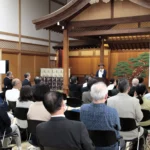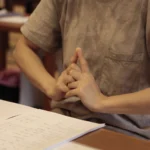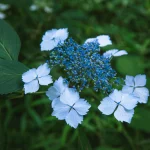By Alice Whieldon MA PhD MRSS(t)
In September/October 2002 I was one of a group of students studying in Japan with our teacher, Akinobu Kishi sensei. The course was a two-week workshop introducing us to the roots of our sensei’s work largely at Shinto shrines near Kyoto. A week of that time was spent with Oomoto, mostly in Kameoka.
Our group consisted of Europeans from various countries (though over half, including myself, were from the UK). We have all attended workshops with Kishi sensei in Europe over the years; the longest-term student had met Kishi in Germany 20 years ago and I have been working with him and organizing his London workshops for about five years.
Most of us came to work with Kishi sensei through Zen Shiatsu. His approach to Shiatsu is very different from that taught by most people in Europe and we all find it much more suited to our understanding. For Kishi, Shiatsu is specifically a Way. His understanding, while highly contemporary, takes much from his love of the traditional Japanese arts and Shinto. Consequently, he wanted to introduce us to Oomoto as the work and ethic offered there is very close to his heart and he felt that we would benefit from being immersed in this culture.
For many of us, coming to a religious institution was a strange experience. I think it is fair to say that as a group we are very interested in spirituality and developing our practice but have found the religions offered us at home tend rather to squash than nourish this impulse. Personally, I have more of a church background than most and have also studied Christian theology and religious studies to a higher degree level and teach religious studies at degree level. Consequently, I am perhaps both a little kinder and a little harder on Christianity as found in the UK. But I do broadly share with my colleagues a sort of weariness with the institutionalized nature of religions in Europe and seek support and inspiration elsewhere.
So there was a mixed feeling among us when we first came to Oomoto – a kind of in-built wariness born of association with our own rather stale religious traditions. Though I would point out that a small number of us are a little kinder to our own traditions and at least one member of our group is a regular churchgoer. But some were certainly a little hesitant at the very notion of institutionalized religion (some of this might be attributed to the anxieties of causing offense by not being aware of the rules of etiquette).
However, by the end of our stay, we all felt that we had gained a great deal from the experience and saw much at Oomoto that will stay with us forever.
Sometimes I think it is easier to come into a religious environment that is new to us. It is possible to see it through relatively unprejudiced eyes and appreciate the spiritual core (or what we imagine is that core) without being distracted.
The connection with nature that we found at Oomoto was powerful. Though there are ecstatic and nature-related elements to all the religions represented in our group–Judaism, Christianity and Islam–I think it is fair to say that these elements tend to be fringe or obscure and, for the most part, these religions are intellectual. For most of us, our religions’ connection with the earth and with embodied humanity has become heavily obscured by the actual difficulty of understanding theology and the emphasis on knowledge and intellect.ect.
The intellectual task of appreciating these religions and the worldly organizations that have grown up around them have rendered them all but obsolete, at least for the moment. Oomoto, and Shinto as a whole, have a connection with nature and nature in humanity that was a deep relief to us.
The fact that the shrines are built with such mindful attention, with natural materials and are, in most cases, open to nature and very much a part of the environment struck us strongly. There was a tangible presence of nature vibrating around us that we found deeply moving. The deep, body-felt, power of the shrines was remarkable. I don’t think anyone will ever forget getting up early to walk, chanting, up and down the shrine steps in the mist at Naigu, or rising in the dark at Kameoka to clean the shrine as the sun came up. The simplicity and power of these rituals are beyond words in their effect.
The workshops we were offered at Oomoto were also powerful experiences. We were able to experience the centering effect of mindfulness in small things, the beauty of being present in every movement, as well as the centrality of hara in different activities. To see the effect of this consistency in the community around us reinforced this feeling.
For many it was the kindness of the Oomoto people, their patience with us (we can be difficult at times as well as noisy and untidy) and their persistence in the face of our clumsiness and forgetfulness that stands out.
This kindness seemed to us to grow out of the strong ethic and consciousness of Oomoto and was just as strong an influence as the workshops and more formal experiences of our time there.
We all left feeling we had had a unique and possibly life-changing experience that we are only slowly assimilating. Indeed, when I recall my first trip to Japan three years before, I know that it will probably take many years to integrate the experience. Everyone I have since spoken to found it a wonderful time in so many different ways that I can only hint at here. Kishi sensei has been inspired in taking us to Oomoto and Oomoto was very generous in their attention. We felt highly privileged to be in this community for even a short time. I and many of the others hope to return and soak in the atmosphere some more.
Alice Whieldon runs workshops in London and organizes Kishi sensei’s London workshops.
Contact her on 07957 233345, e-mail at: alice@seiki.fsnet.co.uk



